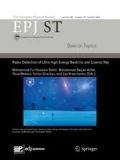Abstract.
Random graphs are useful tools to study social interactions. In particular, the use of weighted random graphs allows to handle a high level of information concerning which agents interact and in which degree the interactions take place. Taking advantage of this representation, we recently defined a magnitude, the Social Inertia, that measures the eagerness of agents to keep ties with previous partners. To study this magnitude, we used collaboration networks that are specially appropriate to obtain valid statitical results due to the large size of publically available databases. In this work, I study the Social Inertia in two of these empirical networks, IMDB movie database and condmat. More specifically, I focus on how the Inertia relates to other properties of the graphs, and show that the Inertia provides information on how the weight of neighboring edges correlates. A social interpretation of this effect is also offered.
Similar content being viewed by others
References
R. Albert, A.-L. Barabási, Rev. Mod. Phys. 74, 47 (2002)
S.N. Dorogovtsev, J.F.F. Mendes, Evolution of networks: From Biological Nets to the Internet and WWW (Oxford University Press, Oxford, 2003)
R. Pastor-Satorras, A. Vespignani, Evolution and structure of the Internet: A statistical physics approach (Cambridge University Press, Cambridge, 2004)
M.E.J. Newman, SIAM Review 45, 167 (2003)
A.-L. Barabási, R. Albert, Science 286, 509 (1999)
R. Albert, H. Jeong, A.-L. Barabási, Nature 401, 130 (1999)
R. Pastor-Satorras, A. Vázquez, A. Vespignani, Phys. Rev. Lett. 87, 258701 (2001)
H. Jeong, B. Tombor, R. Albert, Z.N. Oltvai, A.-L. Barabási, Nature 407, 651 (2000)
B. Schwikowski, P. Uetz, S. Fields, Nat. Biotech. 18, 1257 (2000)
S. Wuchty, Z.N. Oltvai, A.-L. Barabási, Nat. Genet. 35, 176 (2003)
S.H. Yook, H. Jeong, A.-L. Barabási, Y. Tu, Phys. Rev. Lett. 86, 5835 (2001)
M.E.J. Newman, Proc. Natl. Acad. Sci. USA 98, 404 (2001); Phys. Rev. E 64, 016131 and 016132 (2001)
A. Barrat, M. Barthélemy, R. Pastor-Satorras, A. Vespignani, Proc. Natl. Acad. Sci. USA 101, 3747 (2004)
J.J. Ramasco, S.A. Morris, Phys. Rev. E 73, 016122 (2006)
Data available at http://www.nd.edu/ networks/dat-ab-a-s-e/index.html
M.A. Serrano, M. Boguñá, R. Pastor-Satorras, cond-mat/0609029 (2006)
J.J. Ramasco, B. Gonçalves, cond-mat/0609776 (2006)
Author information
Authors and Affiliations
Rights and permissions
About this article
Cite this article
Ramasco, J. Social inertia and diversity in collaboration networks. Eur. Phys. J. Spec. Top. 143, 47–50 (2007). https://doi.org/10.1140/epjst/e2007-00069-9
Issue Date:
DOI: https://doi.org/10.1140/epjst/e2007-00069-9




